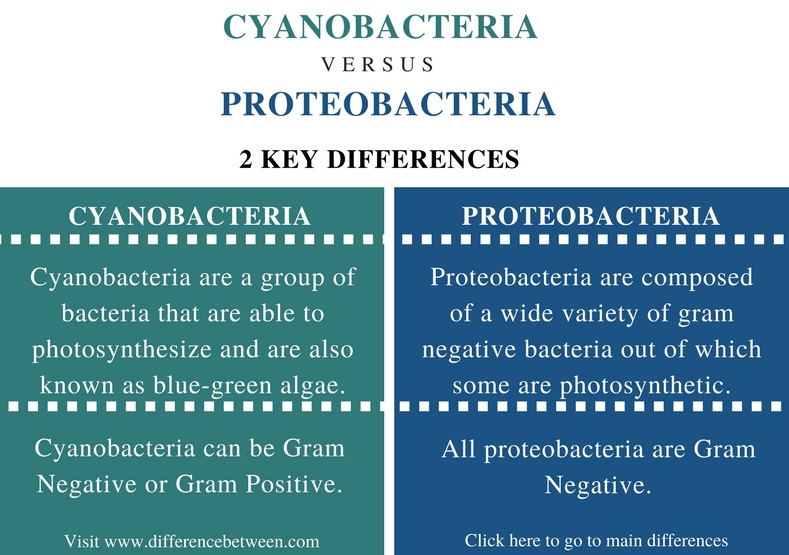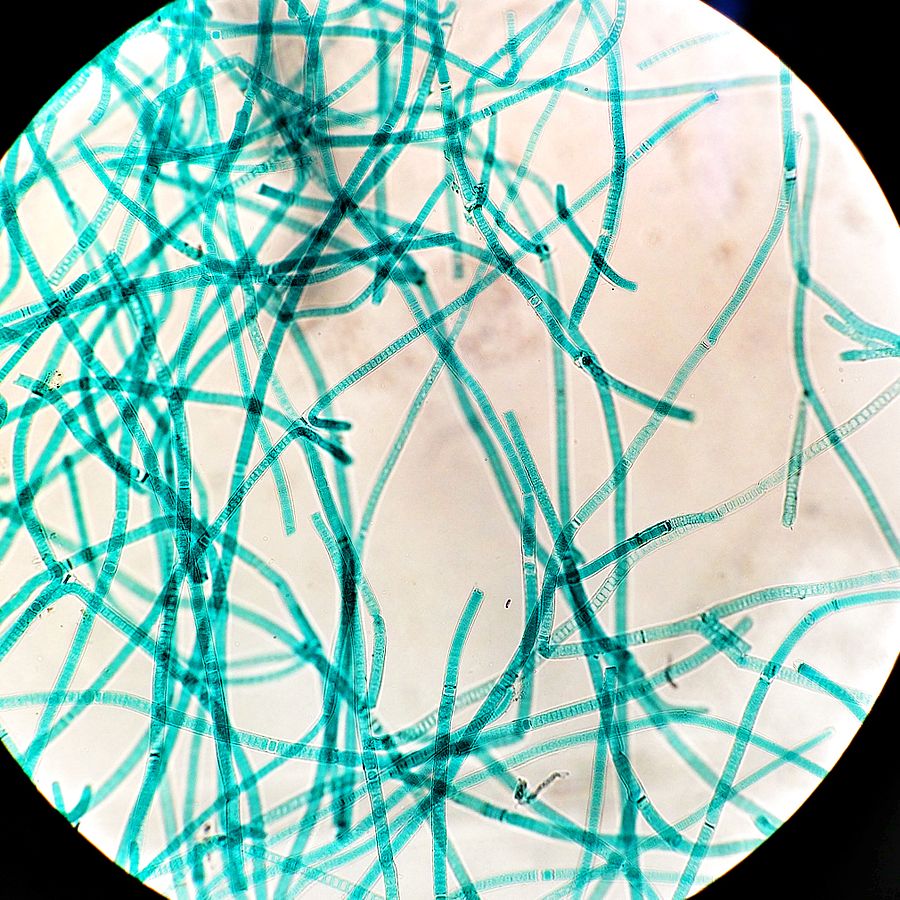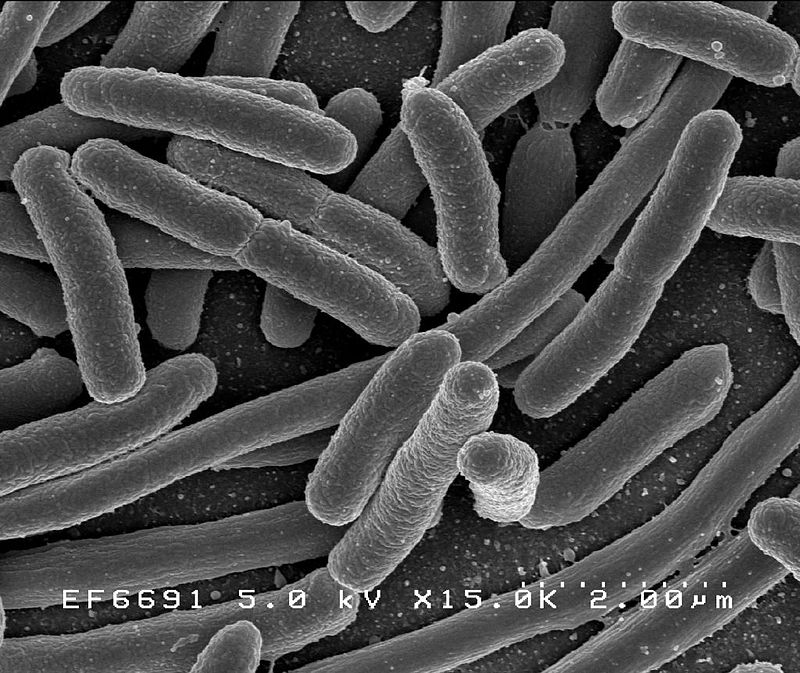The key difference between Cyanobacteria and Proteobacteria cannot be deduced specifically. However, cyanobacteria, known as blue-green algae, are completely photosynthetic while proteobacteria compose of a wide variety of gram negative organisms out of which some organisms are photosynthetic.
Even though Cyanobacteria and Proteobacteria share many characteristics in common, based on their ability to photosynthesize, they may differ from each other. However, they both are industrially important organisms as well as disease-causing organisms.

CONTENTS
1. Overview and Key Difference
2. What are Cyanobacteria
3. What are Proteobacteria
4. Similarities Between Cyanobacteria and Proteobacteria
5. Side by Side Comparison – Cyanobacteria and Proteobacteria in Tabular Form
6. Summary
What are Cyanobacteria?
Cyanobacteria or blue-green algae are photosynthetic bacteria. They are prokaryotic autotrophs and contain different photosynthetic pigments such as chlorophyll a, phycobilin and phycoerythrin. Further, they are unicellular filamentous organisms, and sometimes they exist as cyanobacterial blooms. They carry out the photosynthetic activities using their plasma membranes.
Cyanobacteria are mainly present in freshwater environments and in damp terrestrial environments. Their size varies from 0.5 – 60 µm. Further, binary fission is the main mechanism of cyanobacterial cell proliferation and reproduction. Also, some of these species undergo fragmentation and multiple fission.
Nitrogen Fixation by Cyanobacteria
Cyanobacteria contain a special structure known as heterocyst. Heterocyst is capable of fixing nitrogen from the atmosphere. Furthermore, Cyanobacterial specieas such as Anabaena and Nostoc are capable of fixing atmospheric Nitrogen.
Importance of Cyanobacteria
Cyanobacteria are widely used as nutritional supplements due to the nutrient rich nature of some Cyanobacterial species (Spirulina, Cholerella). Some Cyanobacteria serve as inoculants in the manufacturing process of biofertilizers. Therefore, many symbiotically important relationships, known as Lichen associations, which are extremely important in agriculture, exist between fungi and Cyanobacteria.

Figure 01: Cyanobacteria
In addition, Cyanobacteria accumulation can lead to eutrophication in waterways making them a significant pollutant of water bodies. Therefore, Cyanobacteria also act as indicators of water pollution.
What are Proteobacteria?
Proteobacteria is a broad group of bacteria that include all Gram Negative organisms. Therefore, this group consists of the highest number of bacterial species. These organisms have diverse features. Some of these features include;
- Ability to photosynthesize.
- Capability to fix nitrogen
- Act as pathogenic organisms.
- Can attain different structural morphologies.
- Ability to engage in different metabolic roles.

Figure 02: Proteobacteria
There are six main classes of Proteobacteria; they are,
What are the Similarities Between Cyanobacteria and Proteobacteria?
- Cyanobacteria and Proteobacteria are both belong to the Kingdom Bacteria.
- Both have a prokaryotic cellular organization.
- Some organisms of both groups have the ability to fix nitrogen.
- Both have the ability to act as pathogens.
- They both have species that act as industrially important bacterial species.
What is the Difference Between Cyanobacteria and Proteobacteria?
Cyanobacteria vs Proteobacteria | |
| Cyanobacteria (or blue green algae) are a group of bacteria that are able to photosynthesize. | Proteobacteria compose a wide variety of gram negative bacteria, and out of which, some are photosynthetic. |
| Ability to Photosynthesize | |
| They have the ability to photosynthesize. | Only some species can undergo photosynthesis. |
| Cell Wall Structure | |
| They can be Gram Negative or Gram Positive. | All are Gram Negative. |
Summary – Cyanobacteria vs Proteobacteria
The two groups Cyanobacteria and Proteobacteria are very diverse, therefore, it is very difficult to distinguish the difference between them. In accordance with the characteristics shown by organisms, cyanobacteria are completely photosynthetic organisms whereas only some proteobacteria are photosynthetic. In addition, all proteobacteria are Gram Negative, in contrast only some cyanobacteria are Gram Negative. This is the key difference between Cyanobacteria and Proteobacteria.
Reference:
1.Britannica, The Editors of Encyclopaedia. “Blue-Green Algae.” Encyclopædia Britannica, Encyclopædia Britannica, Inc., 29 Dec. 2017. Available here
2.Boundless. “Proteobacteria.” Lumen – Boundless Microbiology. Available here
Image Courtesy:
1.’Tolypothrix (Cyanobacteria)’By Matthewjparker – Own work, (CC BY-SA 3.0) via Commons Wikimedia https://commons.wikimedia.org/w/index.php?curid=24119070
2.’EscherichiaColi NIAID’By Credit: Rocky Mountain Laboratories, NIAID, NIH – NIAID (Public Domain) via Commons Wikimedia
ncG1vNJzZmivp6x7pbXFn5yrnZ6YsqOx07CcnqZemLyue8OinZ%2Bdopq7pLGMm5ytr5Wau26v2JqlqJqRmMGmvsiaZJqmlGK9s7vTnqabmZOpsrO1wGg%3D